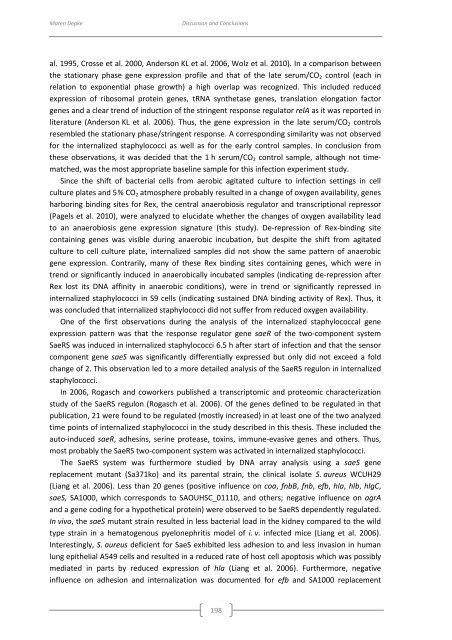genomewide characterization of host-pathogen interactions by ...
genomewide characterization of host-pathogen interactions by ...
genomewide characterization of host-pathogen interactions by ...
You also want an ePaper? Increase the reach of your titles
YUMPU automatically turns print PDFs into web optimized ePapers that Google loves.
Maren Depke<br />
Discussion and Conclusions<br />
al. 1995, Crosse et al. 2000, Anderson KL et al. 2006, Wolz et al. 2010). In a comparison between<br />
the stationary phase gene expression pr<strong>of</strong>ile and that <strong>of</strong> the late serum/CO 2 control (each in<br />
relation to exponential phase growth) a high overlap was recognized. This included reduced<br />
expression <strong>of</strong> ribosomal protein genes, tRNA synthetase genes, translation elongation factor<br />
genes and a clear trend <strong>of</strong> induction <strong>of</strong> the stringent response regulator relA as it was reported in<br />
literature (Anderson KL et al. 2006). Thus, the gene expression in the late serum/CO 2 controls<br />
resembled the stationary phase/stringent response. A corresponding similarity was not observed<br />
for the internalized staphylococci as well as for the early control samples. In conclusion from<br />
these observations, it was decided that the 1 h serum/CO 2 control sample, although not timematched,<br />
was the most appropriate baseline sample for this infection experiment study.<br />
Since the shift <strong>of</strong> bacterial cells from aerobic agitated culture to infection settings in cell<br />
culture plates and 5 % CO 2 atmosphere probably resulted in a change <strong>of</strong> oxygen availability, genes<br />
harboring binding sites for Rex, the central anaerobiosis regulator and transcriptional repressor<br />
(Pagels et al. 2010), were analyzed to elucidate whether the changes <strong>of</strong> oxygen availability lead<br />
to an anaerobiosis gene expression signature (this study). De-repression <strong>of</strong> Rex-binding site<br />
containing genes was visible during anaerobic incubation, but despite the shift from agitated<br />
culture to cell culture plate, internalized samples did not show the same pattern <strong>of</strong> anaerobic<br />
gene expression. Contrarily, many <strong>of</strong> these Rex binding sites containing genes, which were in<br />
trend or significantly induced in anaerobically incubated samples (indicating de-repression after<br />
Rex lost its DNA affinity in anaerobic conditions), were in trend or significantly repressed in<br />
internalized staphylococci in S9 cells (indicating sustained DNA binding activity <strong>of</strong> Rex). Thus, it<br />
was concluded that internalized staphylococci did not suffer from reduced oxygen availability.<br />
One <strong>of</strong> the first observations during the analysis <strong>of</strong> the internalized staphylococcal gene<br />
expression pattern was that the response regulator gene saeR <strong>of</strong> the two-component system<br />
SaeRS was induced in internalized staphylococci 6.5 h after start <strong>of</strong> infection and that the sensor<br />
component gene saeS was significantly differentially expressed but only did not exceed a fold<br />
change <strong>of</strong> 2. This observation led to a more detailed analysis <strong>of</strong> the SaeRS regulon in internalized<br />
staphylococci.<br />
In 2006, Rogasch and coworkers published a transcriptomic and proteomic <strong>characterization</strong><br />
study <strong>of</strong> the SaeRS regulon (Rogasch et al. 2006). Of the genes defined to be regulated in that<br />
publication, 21 were found to be regulated (mostly increased) in at least one <strong>of</strong> the two analyzed<br />
time points <strong>of</strong> internalized staphylococci in the study described in this thesis. These included the<br />
auto-induced saeR, adhesins, serine protease, toxins, immune-evasive genes and others. Thus,<br />
most probably the SaeRS two-component system was activated in internalized staphylococci.<br />
The SaeRS system was furthermore studied <strong>by</strong> DNA array analysis using a saeS gene<br />
replacement mutant (Sa371ko) and its parental strain, the clinical isolate S. aureus WCUH29<br />
(Liang et al. 2006). Less than 20 genes (positive influence on coa, fnbB, fnb, efb, hla, hlb, hlgC,<br />
saeS, SA1000, which corresponds to SAOUHSC_01110, and others; negative influence on agrA<br />
and a gene coding for a hypothetical protein) were observed to be SaeRS dependently regulated.<br />
In vivo, the saeS mutant strain resulted in less bacterial load in the kidney compared to the wild<br />
type strain in a hematogenous pyelonephritis model <strong>of</strong> i. v. infected mice (Liang et al. 2006).<br />
Interestingly, S. aureus deficient for SaeS exhibited less adhesion to and less invasion in human<br />
lung epithelial A549 cells and resulted in a reduced rate <strong>of</strong> <strong>host</strong> cell apoptosis which was possibly<br />
mediated in parts <strong>by</strong> reduced expression <strong>of</strong> hla (Liang et al. 2006). Furthermore, negative<br />
influence on adhesion and internalization was documented for efb and SA1000 replacement<br />
198

















